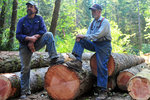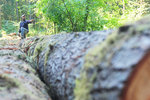

If it were 2008, Steve Stinson and his father may have been nervous about cutting down their stand of large-diameter Douglas fir south of Chehalis that was beginning to show signs of root rot.
But the insatiable staying power of a recently emerged overseas market prodded the Stinsons into confidently salvaging their timber last September.
“If we didn’t have China right now we would be in a world of hurt,” said Stinson, speaking generally of his family’s Cowlitz Ridge Tree Farm business.
Meanwhile, the domestic housing market remains as depressed as it was four years ago.
And while China’s voracious buying of timber exports has kept private landowners like the Stinsons solvent, it has also choked off and upended a local stud mill and workers.
At the end of this month Hampton Affiliates will lay off 80 workers in Randle because it can’t compete globally for local timber.
“The Chinese are willing to pay more for logs than we can and break even,” said Steve Zika, chief executive officer of Hampton.
In 1997, Hampton bought three mills in Morton, Randle and Packwood. The Portland-based company shuttered the Packwood mill immediately because, at the far end of east Lewis County, it was geared to receive wood solely from the Gifford Pinchot National Forest, while the 1990 listing of the northern spotted owl as a threatened species had already drastically curtailed timber harvests on U.S. Forest Service lands in the Northwest.
But private landowners kept the Morton and Randle mills flush with wood.
The mills’ capacities today are geared to receive 70 percent of their wood from private landowners, the rest from the Gifford Pinchot forest, Zika said.
The 2008 crash of the stock market, however, caused housing starts to falter. Demand for materials fell and prices for lumber plunged.
Nothing’s changed much since.
Timber from public lands, which can’t be exported, continues to provide Hampton a quarter of its supplies. But strongly competing for open-market logs has proven untenable for Randle’s normal operations as retail lumber prices remain low.
By cutting 80 positions, the stud mill goes from 80 hours a week to 50 — indefinitely.
“I don’t know when the U.S. housing market is going to come back, I don’t know if anybody does,” Zika said.
China’s Demand
The story of China instantly devouring timber exports begins with Russia, according to an economist with the Washington state Department of Natural Resources.
Until 2009, Russia had been China’s main supplier of wood. But Russia placed a high tariff on timber to keep raw materials at home while developing its own lumber industry.
“China started buying logs on the West Coast, and along the Pacific Rim, and they came and bought a lot,” said DNR economist Dorian Smith. “We have a raw material that has a big customer.”
For the first time since 1996, Smith said more than 1 billion board feet of timber — yes, billion — was exported overseas from Washington.
The state exported 661 million board feet in 2008.
After returning less than two weeks ago from a trip to China with Oregon Gov. John Kitzhaber, Zika said China has plenty of construction underway but it appears to be slowing down.
Meanwhile, Hampton Affiliates is producing metric-sized studs — 100 percent production at the Tillamook, Ore., mill and 50 percent production at the Randle mill — to meet China’s demand with finished products rather than raw materials.
But the DNR economist warns of China’s deceiving slowdown. There is an enormous supply of imported timber in the country’s ports that haven’t been milled while efforts are underway to ramp up production.
“I was told there are hundreds of sawmills being built in China,” Smith said.
Stinson said he feels uncomfortable relying on China for his family’s private timber business, although a lot of its smaller-diameter wood is still sent to local mills such as Hampton.
However, he estimates more than 75 percent of his family’s large-diameter timber — 8 inches or bigger — is now shipped overseas to China.
“If we’re going to stay alive, and this tree farm is here for the next 1,000 years, we have to stay competitive,” Doug Stinson, Steve’s father, said.
•••
Coming Tomorrow
On Saturday, reporter Adam Pearson delves into the historical supply of timber on the Gifford Pinchot National Forest and where it stands today.
•••
Adam Pearson: (360) 807-8208